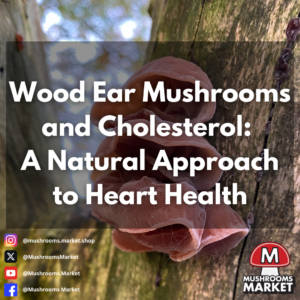
Wood Ear Mushrooms and Cholesterol: A Natural Approach to Heart Health
Wood Ear mushrooms (Auricularia auricula-judae), known for their crunchy texture and subtle flavor, are more than just a staple in Asian cuisine—they might also be
Fungi present an intriguing, diverse, and important group that includes molds, mushrooms, yeasts, and numerous other forms. Fungi show remarkable diversity in morphological, physiological, and ecological characteristics. In this article, we will dive deeper into what fungi are and their differences from plants and animals, as well as the nutritional properties of each kingdom.
But first, let us learn about the Kingdom of Fungi
The Kingdom of Fungi is a separate domain from plants and animals, comprising over 144,000 species. Unlike plants, fungi are heterotrophic and don’t have chlorophyll, which means they cannot produce their food through photosynthesis. Instead, fungi obtain their nutrients by absorbing them from organic matter such as dead animals, decaying plants, and other fungi. In contrast, animals ingest their food, while plants manufacture their own food through photosynthesis. Fungi are eukaryotic organisms, meaning they have membrane-bound organelles and a nucleus with DNA. Fungi belong to the Kingdom of Fungi, which is one of the five kingdoms of eukaryotes. Fungi were once classified as plants, but now they are recognized as a distinct group because of several unique characteristics. Apart from being heterotrophic, fungi also have cell walls made of chitin, which distinguishes them from both plants and animals. Chitin is a strong and durable substance that provides structural support to the cell, making it resistant to physical damage. Fungi cells also have specialized structures known as hyphae that allow them to penetrate and digest food. Hyphae can be described as long, thin, and branching tubes that grow and spread to form a network known as mycelium.
Now let’s look into the Nutritional Properties of Fungi, Plants, and Animals
Fungi, Plants, and Animals have different nutritional properties, here is an overview of each:
Fungi
Fungi come in different shapes, sizes, and textures and are widely used in both culinary and medicinal contexts. They are an excellent source of vitamins B and D, essential minerals such as copper, selenium, and zinc, and beneficial amino acids that the human body requires. Some fungi present specific health benefits. For instance, Shiitake mushrooms have been found to have immunostimulatory qualities and can improve the function of the body’s immune system. Another example is the turkey tail mushroom, which has unique polysaccharides that show antitumor effects and improve immunity.
Plants
Plants are known for their ability to carry out photosynthesis, a process that enables them to create organic compounds. They are an excellent source of vitamins, minerals, and fiber. They provide various health benefits such as reducing the risk of chronic diseases, including cancer, diabetes, and heart disease. Different plants offer different nutritional properties. For example, leafy greens such as kale and spinach are high in vitamins A, C, and K, and minerals such as iron and calcium. Fruits such as blueberries and strawberries are rich in antioxidants that are beneficial to cell health. Plants are excellent sources of essential nutrients such as carbohydrates, proteins, vitamins, minerals, and fiber. These nutrients are crucial for maintaining a healthy body and preventing chronic diseases such as obesity, diabetes, and heart diseases. They are also an excellent source of dietary fiber, which is crucial for maintaining a healthy digestive system, reducing the risk of colon cancer, and regulating blood sugar levels. In addition, plants are rich in vitamins C and E, which act as antioxidants and help prevent cellular damage caused by free radicals.
Animals
Animals provide a similar range of nutritional benefits as fungi and plants. They help provide essential amino acids such as tryptophan and lysine. They also offer important sources of minerals such as iron, selenium, and zinc. Animal products such as dairy and meat are good sources of vitamin B12. Unlike plants, animals are rich in proteins, fats, and other essential nutrients, such as iron, calcium, and vitamin B12, which are necessary for the proper functioning of the body. However, there is growing evidence that diets that are high in meat and dairy products are linked to an increased risk of chronic diseases, such as heart disease, cancer, and diabetes. Furthermore, animal products such as meat, poultry, and dairy products are excellent sources of protein, which is essential for the growth and repair of muscles, tissues, and organs. Animal products are also rich in essential fats, such as omega-3 and omega-6 fatty acids, which are crucial for maintaining a healthy heart. However, animal products are also high in saturated fats, which can increase the risk of heart disease and other chronic illnesses when consumed in excess.
On the other hand, Fungi, which are often overlooked, have unique nutritional properties that make them a valuable addition to the diet. Mushrooms, for instance, are low in calories and fat and are an excellent source of vitamins B and D. In addition, mushrooms are rich in antioxidants, such as ergothioneine, which help protect cells from oxidative stress. Fungi are also a good source of dietary fiber, potassium, and selenium, which are essential nutrients for maintaining a healthy body.
Conclusion:
In conclusion, Fungi are part of one of the essential kingdoms on earth, and they are distinct from both plants and animals. The group shows a unique combination of features that sets them apart from the other kingdoms. Understanding the differences and uniqueness of fungi is necessary to fully appreciate these fascinating and vital organisms and their role in the ecosystem.
Fungi have distinct nutritional benefits that make it worthwhile to include in one’s diet, providing an array of vitamins, minerals, and amino acids. While plants and animals remain important sources of nutrition, increasing evidence shows that diets with a higher proportion of plant-based foods can confer benefits for human health, as well as the environment. Also, plants, animals, and fungi have unique nutritional properties that make them essential components of a healthy and balanced diet. While plants are an excellent source of essential nutrients such as carbohydrates, vitamins, and fiber, animal products are rich in proteins and essential fats. Fungi, on the other hand, are an excellent source of dietary fiber, vitamins, and antioxidants. Therefore, a balanced diet that incorporates all three types of foods is crucial for maintaining optimal health and preventing chronic diseases.

Wood Ear mushrooms (Auricularia auricula-judae), known for their crunchy texture and subtle flavor, are more than just a staple in Asian cuisine—they might also be

In recent years, wellness seekers and holistic health enthusiasts have turned their attention to the forest floor—not for herbs or roots, but for medicinal mushrooms.

In the growing search for natural, plant-based medicines, few fungi stand out as strongly as Agarikon (Fomitopsis officinalis). Known as a rare and ancient medicinal
FDA Disclaimer: These products have not been evaluated by the Food and Drug Administration and are not intended to diagnose, treat, cure or prevent any disease.
© 2025 Mushrooms Market - All Rights Reserved